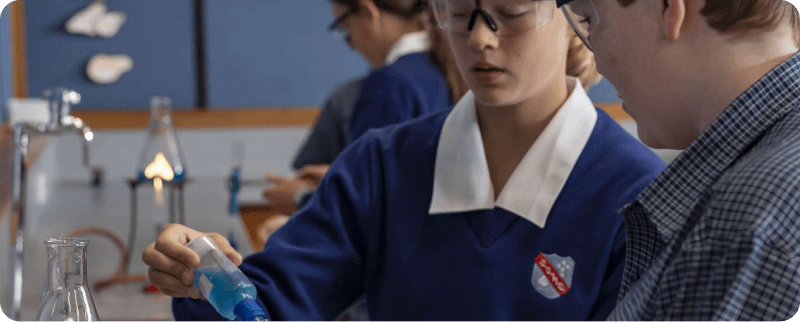South Otago High School
Education Perfect enhances South Otago High School’s classroom differentiation and personalised assessments
Education Perfect has been successfully integrated into South Otago High School, supporting a school-wide focus on differentiation and the assessment of individual student needs. Rod Deverson, Deputy Head of English, describes the impact that Education Perfect has had on teaching and learning within the English Department and across the school.

Located in Balclutha in the Clutha District of New Zealand, South Otago High School caters to Years 9-13 with approximately 500 students. Rod Deverson wears multiple hats in his roles as Teacher, Deputy Head of English, and IT Manager. He has overseen the integration of Education Perfect (EP) into his own department, and – through his edtech leadership role – into the rest of the school.
EP is now firmly embedded in the Maths, English, Science and Social Science Departments across Year 9 and 10. EP, a comprehensive digital toolkit, contains learning, assessment and analytics features across a range of global subjects and curriculums. For more information on the platform’s resources, explore the company’s homepage.
The Challenge
South Otago High School’s challenge in recent years was to increase differentiation across all curriculum areas. As part of the school’s strategic plan, teachers were supported by a professional development programme where accurate assessment of individual learners was identified as critical, and the use of digital tools to support this was greatly encouraged.
The departments also hoped to address other challenges. Rod, as a leader in the English Department, was keen to ensure consistent curriculum coverage and assessment across all six English classes, and wanted to support new staff to cover the basics.
Rod Deverson
Deputy Head of English

“I could see straight away that EP absolutely aligned with the New Zealand English curriculum and would assist us to identify, cover off, and assess a number of language devices each term, as a team.”

The Solution
EP was integrated over a number of years, beginning with French, then shifting into Maths and English, and lastly Science and Social Sciences. Each department tailored their approach to EP to meet their own needs. Rod explains, “In Science, where they cover a block of knowledge, they use EP for pre-testing throughout the module to monitor progress, and for post-testing. English is a different beast as our subject is more skills than knowledge-based, with no end to speak of. We continually build on reading and writing skills, so we use EP in a more formative way, consistently checking students’ understanding of our target language devices.”
Rod selects the appropriate topics in EP for all classes, ensuring consistent curriculum coverage across the year as a whole.
The Impact
For Rod, in both his classroom and across the department, EP has made the school-wide objective for greater differentiation easily achievable.
“I have levels of ability ranging from two to six in my classroom, but EP has made it possible for me to sort my students into ability groups and set an activity,” he says. “I know that for the next fifteen minutes, they are engaged in tasks pitched to their individual level, and they are motivated because of the gamified nature of EP.”
In addition to supporting differentiation, EP has also expanded the English Department’s scope in terms of assessment focus.
“EP assesses our student’s language at a micro-level, like picking up issues with the use of commas or spelling. Previously, it just wasn’t possible for teachers to drill down to that level consistently with every student. Now, we can focus more on teaching and assessing the ‘macro’ creative writing skills, whilst EP provides practice, assesses and reports on the basics.”
As a by-product of EP’s expansion across the school, Rod and his colleagues have noticed that students are more confident using the platform’s online tools.
“We talk about this generation being digital natives, but really, they are still young and learning to navigate these tools. By consolidating our choice of platform across five departments, we have made it so much easier for the students while also facilitating hybrid teaching, especially during Covid. EP has also become a vehicle for the ten percent of students who want to extend themselves further to delve deeper into a subject outside of the classroom.”
Rod Deverson
Deputy Head of English

“Each class works their way through the topic activities during a dedicated ten to fifteen minute slot. For example, we might be looking at similes in a book we are studying, so the students will do a number of questions on similes. EP will recommend further activities for any students who are struggling with that element. Crucially though, it also identifies them to the teacher, and we can immediately allocate some one-on-one time to go through the concept with them in person.”

Summary
EP has filled a vital gap in South Otago High School’s data and assessment arsenal. The platform has facilitated differentiation by quickly identifying students who need extra support with a topic. Teachers are able to respond immediately with real-time, one-on-one assistance, rather than waiting until the end of a unit, post-summative assessment. EP has allowed students to be grouped by ability and set appropriate tasks or extensions as individually needed. South Otago has also reaped wider benefits from its use of EP; the consistent curriculum coverage has significantly increased student engagement, and ease of use across subjects and classes.
LAST UPDATED
Jan 25, 2024
CATEGORY
Case studies




